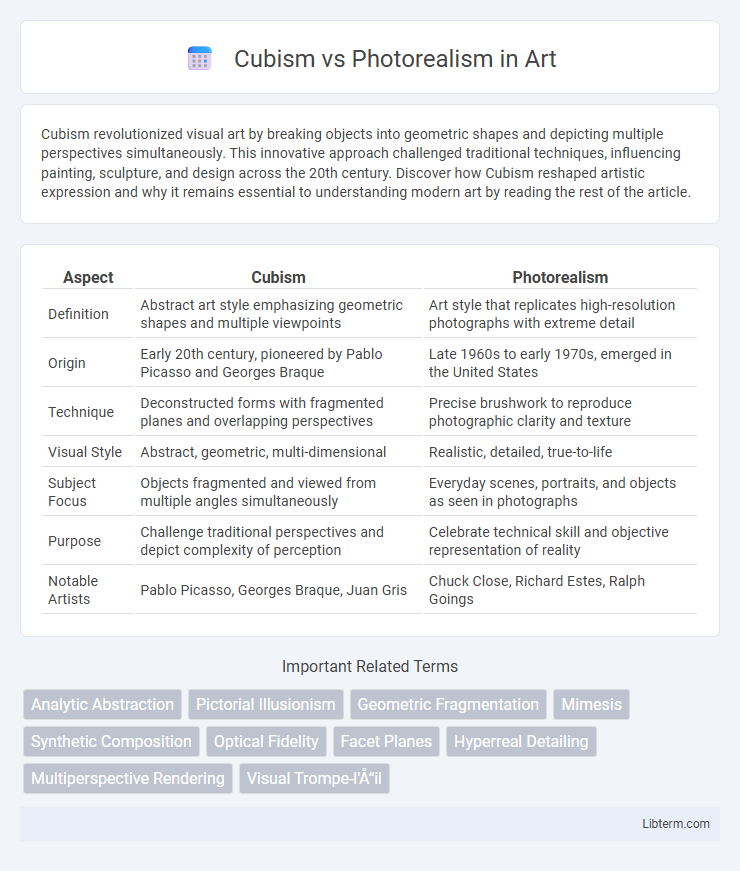Cubism revolutionized visual art by breaking objects into geometric shapes and depicting multiple perspectives simultaneously. This innovative approach challenged traditional techniques, influencing painting, sculpture, and design across the 20th century. Discover how Cubism reshaped artistic expression and why it remains essential to understanding modern art by reading the rest of the article.
Table of Comparison
| Aspect | Cubism | Photorealism |
|---|---|---|
| Definition | Abstract art style emphasizing geometric shapes and multiple viewpoints | Art style that replicates high-resolution photographs with extreme detail |
| Origin | Early 20th century, pioneered by Pablo Picasso and Georges Braque | Late 1960s to early 1970s, emerged in the United States |
| Technique | Deconstructed forms with fragmented planes and overlapping perspectives | Precise brushwork to reproduce photographic clarity and texture |
| Visual Style | Abstract, geometric, multi-dimensional | Realistic, detailed, true-to-life |
| Subject Focus | Objects fragmented and viewed from multiple angles simultaneously | Everyday scenes, portraits, and objects as seen in photographs |
| Purpose | Challenge traditional perspectives and depict complexity of perception | Celebrate technical skill and objective representation of reality |
| Notable Artists | Pablo Picasso, Georges Braque, Juan Gris | Chuck Close, Richard Estes, Ralph Goings |
Introduction to Cubism and Photorealism
Cubism, pioneered by Pablo Picasso and Georges Braque in the early 20th century, revolutionized art by breaking objects into geometric shapes and presenting multiple perspectives simultaneously. Photorealism, emerging in the late 1960s, emphasizes precise, detailed, and lifelike depictions, often using photographs as references to create paintings indistinguishable from high-resolution images. These movements contrast in technique and intention, with Cubism abstracting reality and Photorealism striving for exact visual replication.
Historical Origins and Development
Cubism emerged in the early 20th century, pioneered by Pablo Picasso and Georges Braque, as a revolutionary approach that fragmented objects into geometric shapes to depict multiple perspectives simultaneously. Photorealism developed in the late 1960s as a response to abstract art, characterized by meticulous attention to detail and the replication of photographs with high precision, emphasizing optical accuracy. The historical trajectory of Cubism emphasized conceptual abstraction and innovation, while Photorealism focused on technical skill and realistic representation rooted in contemporary photographic technology.
Key Philosophies Behind Each Movement
Cubism emphasizes abstracted forms and multiple perspectives to challenge traditional representation, focusing on deconstructing objects into geometric shapes and fragmented viewpoints. Photorealism prioritizes meticulous detail and precise replication of photographic images, aiming to achieve an exact likeness that captures the reality of the subject. The philosophical divide centers on abstraction and conceptual interpretation in Cubism versus fidelity and visual accuracy in Photorealism.
Major Artists and Their Influential Works
Pablo Picasso and Georges Braque pioneered Cubism, with Picasso's "Les Demoiselles d'Avignon" and Braque's "Violin and Candlestick" deconstructing objects into geometric forms to challenge traditional perspectives. Photorealism features artists like Chuck Close, known for his massive-scale portraits such as "Big Self-Portrait," and Richard Estes, whose hyper-detailed urban scenes like "Bus Reflections" replicate photographic clarity. These artists profoundly shaped their movements by redefining visual representation--Cubism through abstract fragmentation and Photorealism via meticulous detail and lifelike accuracy.
Techniques and Artistic Methods
Cubism employs fragmented geometric shapes and multiple perspectives to depict subjects in a deconstructed form, challenging traditional representation. Photorealism relies on meticulous attention to detail and precise rendering techniques, often using photographs as reference to create lifelike and highly detailed images. Cubists emphasize abstract interpretation and conceptual depth, while photorealists prioritize visual accuracy and surface texture.
Visual Characteristics: Abstract vs. Realistic
Cubism deconstructs objects into geometric shapes and fragmented perspectives, emphasizing abstraction and multiple viewpoints simultaneously. Photorealism strives for meticulous detail and precision, replicating scenes with exactness that mimics high-resolution photography. The visual contrast lies in Cubism's abstract, interpretive forms against Photorealism's focus on realistic, lifelike representation.
Impact on Modern and Contemporary Art
Cubism revolutionized modern art by breaking objects into geometric shapes and presenting multiple perspectives simultaneously, influencing abstraction and conceptual approaches in contemporary art. Photorealism emphasized meticulous detail and precision, pushing boundaries of technical skill and challenging perceptions of reality in art. Both movements redefined artistic expression, with Cubism shaping avant-garde experimentation and Photorealism advancing hyperrealism and visual accuracy in contemporary practice.
Reception by Critics and the Public
Cubism, pioneered by artists like Pablo Picasso and Georges Braque, initially faced skepticism and confusion from both critics and the public due to its abstract, fragmented depiction of subjects challenging traditional perspectives. Photorealism, emerging in the late 1960s with artists such as Chuck Close and Richard Estes, garnered acclaim for its meticulous attention to detail and startlingly lifelike representations, appealing to a broader audience appreciative of technical skill and visual accuracy. Over time, Cubism gained recognition for its profound influence on modern art and conceptual approaches, while Photorealism maintained popularity for celebrating precision and challenging perceptions of reality.
Comparisons in Subject Matter Representation
Cubism fragments subjects into geometric shapes, emphasizing multiple perspectives within a single image, challenging traditional forms of representation by abstracting reality. Photorealism strives for meticulous detail and accuracy, replicating scenes with near-camera precision to create lifelike images. While Cubism explores conceptual and interpretive visuals, Photorealism prioritizes exact replication of surfaces, textures, and light in everyday subjects.
Legacy and Continued Influence in Art Today
Cubism revolutionized modern art by deconstructing objects into geometric shapes and multiple perspectives, influencing abstract and contemporary art practices worldwide. Photorealism, emphasizing meticulous detail and precision, pushed boundaries in realism and inspired digital art, hyperrealism, and visual storytelling in various media. Both movements continue to shape artistic innovation, bridging traditional craftsmanship and modern conceptual approaches in galleries, education, and visual culture.
Cubism Infographic

 libterm.com
libterm.com